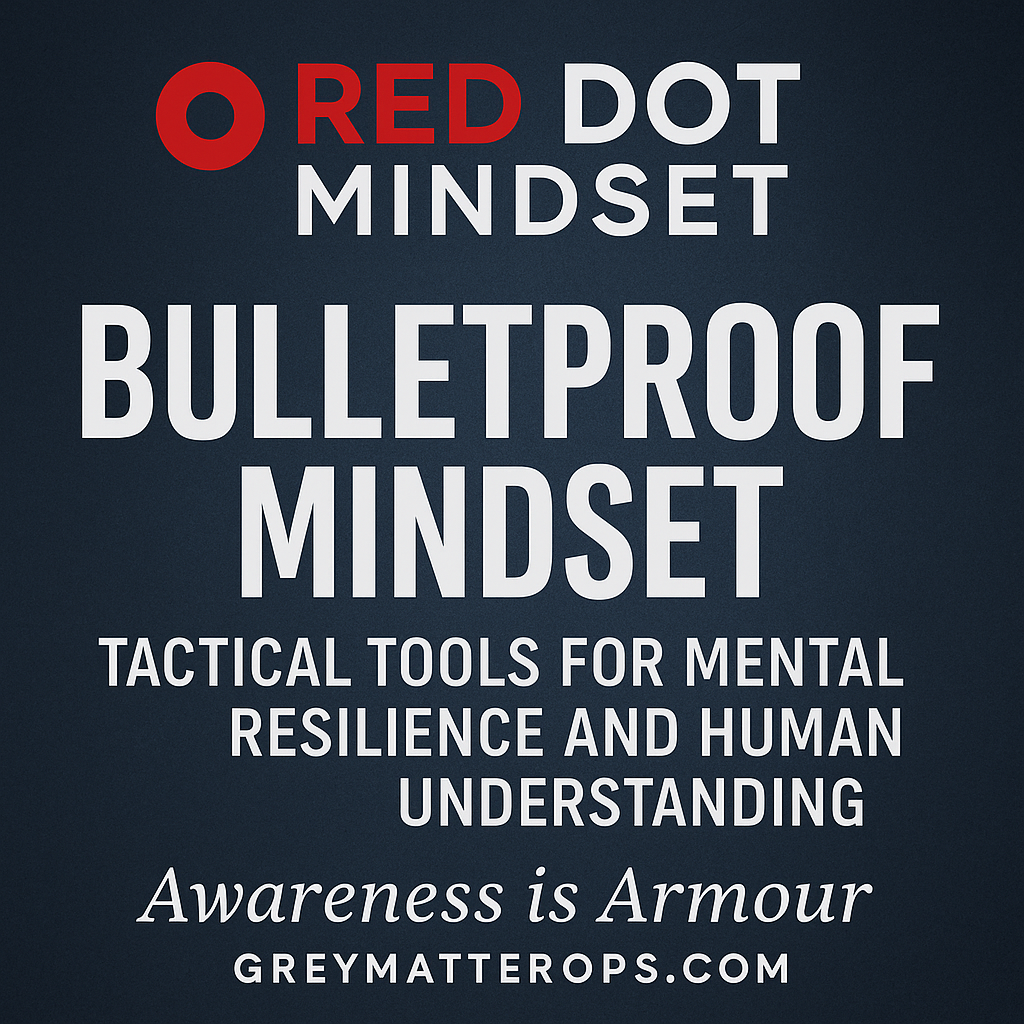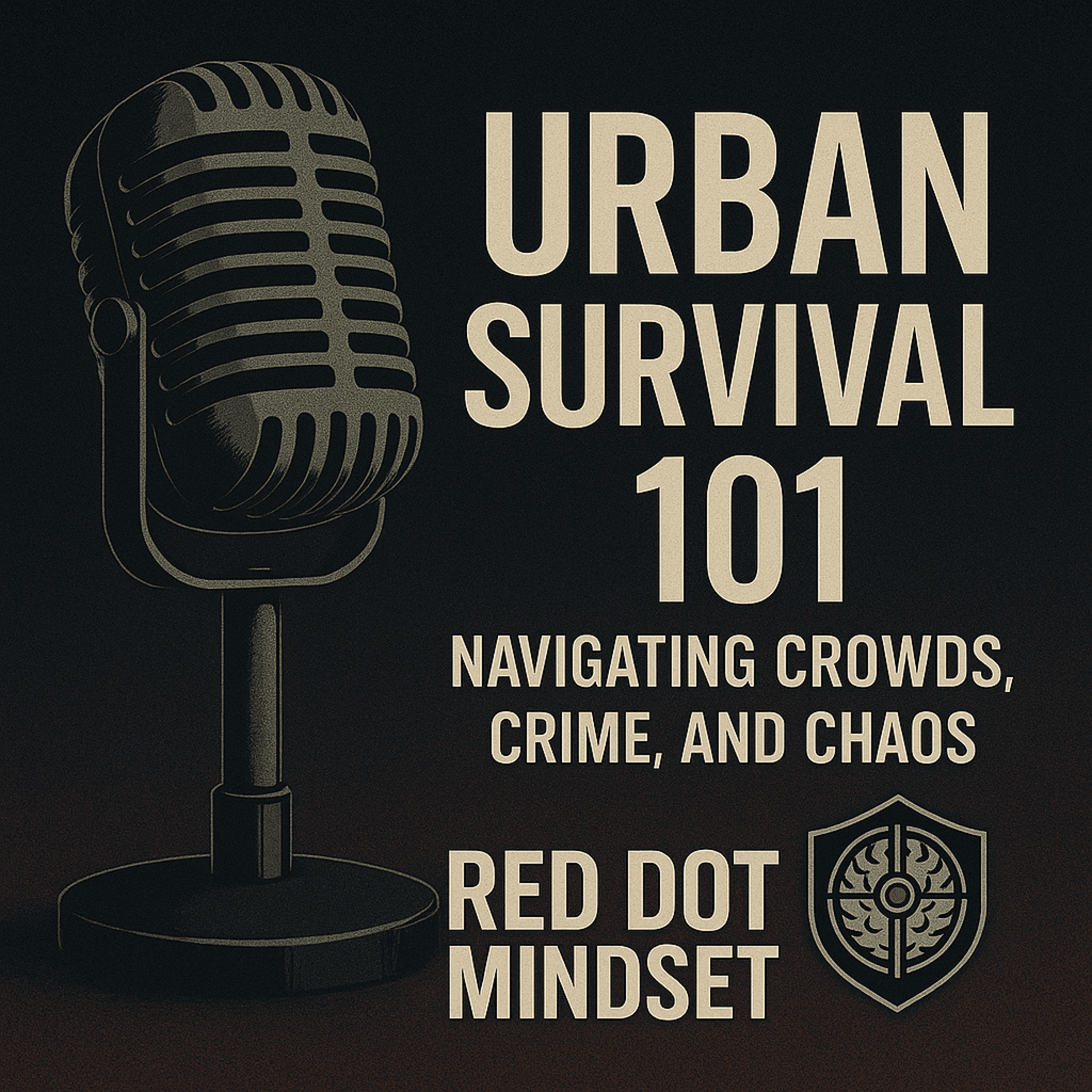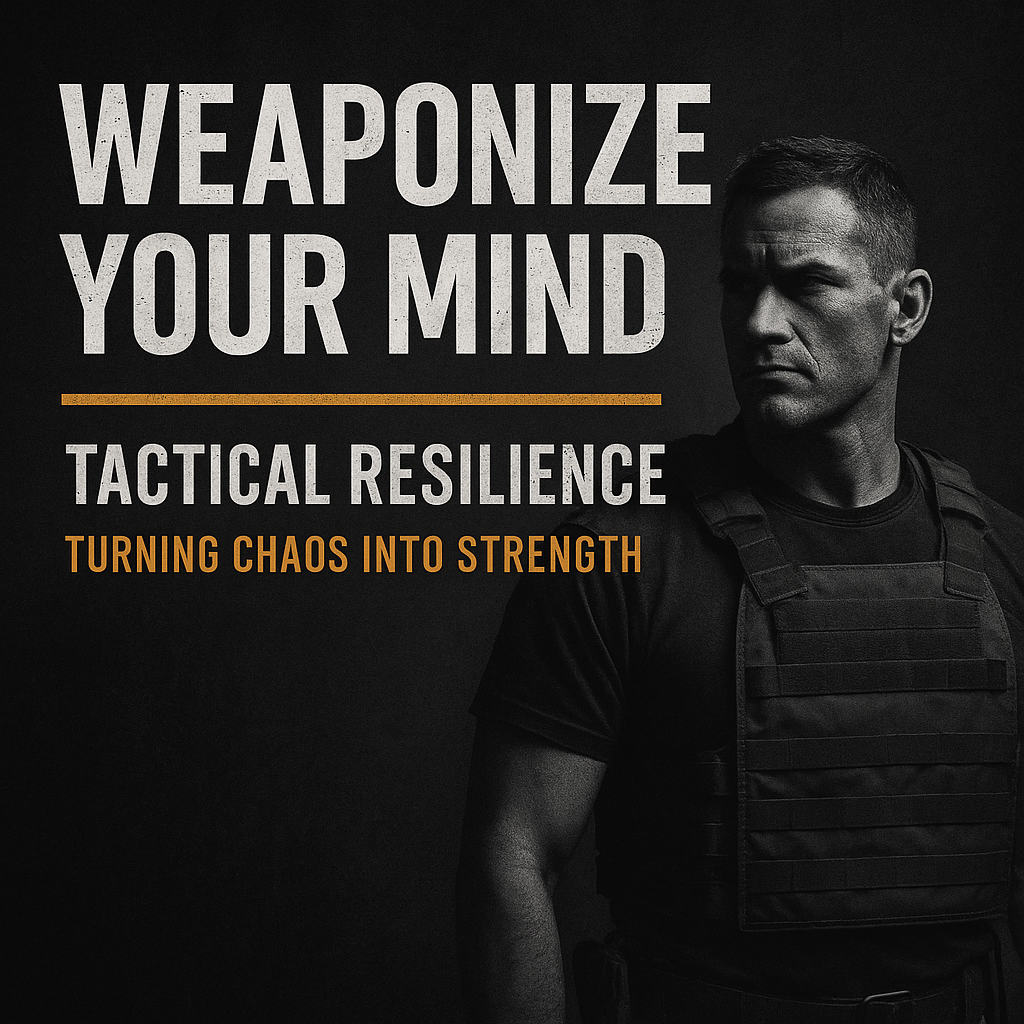Episode Transcript
[00:00:00] Speaker A: In today's world, whether you're, you know, in a tough negotiation or just dealing with everyday life, control really starts in your head. Understanding fear, understanding other people.
[00:00:09] Speaker B: Yeah.
[00:00:10] Speaker A: It's not just survival. It's about, well, dominating your space. You need that bulletproof mindset.
[00:00:15] Speaker B: Absolutely. And to really get you equipped, we've focused on the work of Evie Poupouris. You know, the former Secret Service agent. We've really dug into her book Becoming Bulletproof and pulled in insights from gray matter ops 2, focusing on that practical tactical readiness.
[00:00:28] Speaker A: Right. So our mission here is pretty straightforward and give you actionable, no fluff strategies. Harden your mind, manage stress, get a read on people, think like a tactical coach. Clear, confident, ready.
Like Gray Matter Ops puts it, awareness is armor. Okay, let's get into it.
[00:00:45] Speaker B: Okay. So the bedrock, as Punkouris lays it out, is really getting a handle on your own fear. It's a tool, right, for survival.
But if you don't manage it, it can work against you.
[00:00:56] Speaker A: And she splits fear into two main types. Yeah. First, you've got innate fears. The stuff we're born with, like a sudden loud bang or that feeling of falling. Some notes even suggested maybe predators or pain. Those kinds of primal things. The key is knowing if it's that deep instinct or something learned.
[00:01:12] Speaker B: Then there are the acquired fears. These get shaped by, well, everything. Experiences, trauma, media, you name it. And these, they can often get blown way out of proportion.
[00:01:21] Speaker A: Right. And the way to counter those, the acquired ones that might be irrational, isn't hiding from them. It's rational thinking. Know the facts, the actual statistics, assess the threats. Threat with logic, not just pure emotion. It reminds me of Hans Rosling's work in factfulness.
[00:01:37] Speaker B: Precisely. Rosling talked about how we tend to freak out about rare, splashy dangers like, say, terrorist attacks. But we often underestimate the common everyday risks. Things like, you know, alcohol abuse or poor health habits.
[00:01:50] Speaker A: Okay, so we understand how fear works. What's the next tactical piece? Our actual reaction when things get real. That whole fight, flight, or freeze thing?
[00:01:59] Speaker B: Yeah, that's your default programming. Under stress and knowing your specific default, do you tend to fight back, run, or just lock up? That's critical information.
Recognizing that pattern is the first step.
[00:02:11] Speaker A: And Porus really pushes for moving from just that automatic reaction to a conscious, considered response. It's not about ignoring your gut.
[00:02:20] Speaker B: No, not at all. It's about creating a sliver of time to actually think.
[00:02:24] Speaker A: That connects to Kelly McGonigal's pause and plan idea. Right. Slow things down internally.
[00:02:30] Speaker B: Exactly. You Intentionally slow your heart rate, Maybe take a deep breath. That helps engage the prefrontal cortex, your brain's strategy center, so you can respond tactically instead of just panicking.
[00:02:40] Speaker A: That makes a huge difference. Like if your instinct is always run, pausing might show you that running is actually riskier. In that moment, maybe finding cover or even asserting yourself is the better move.
[00:02:49] Speaker B: Precisely. Now, this mental toughness, this resilience, it's not just forged in a crisis. A truly bulletproof mind gets built day in, day out in the mundane.
[00:02:58] Speaker A: Okay, so how do we build that daily mental armor? What are the core strategies?
[00:03:02] Speaker B: Well, there are a few non negotiables. First, face reality, see things as they are, but balance it. Optimism, yes, but tempered with clear awareness of potential negatives. Prepare, don't paralyze.
[00:03:15] Speaker A: And taking ownership. That sounds key.
[00:03:17] Speaker B: Absolutely critical. Full responsibility for your choices. That builds a sense of control.
Shift focus from blame to solutions, always solutions.
And fundamentally, you need to build stress tolerance deliberately through controlled exposure. What they call stress inoculation training.
[00:03:36] Speaker A: Okay, wait. Stress inoculation, break that down. How does that work in practice?
[00:03:40] Speaker B: You start small, find a discomfort you can manage, experience it, then consciously work through it. Use your breathing, observe your reaction, repeat it. Your nervous system literally adapts over time. You get tougher poom.
[00:03:51] Speaker A: Porus has that four step hormesis process for this, doesn't she?
[00:03:54] Speaker B: She does. Step one, Id manageable stressors. Two, experience them. Watch yourself, react objectively. Three, adjust your strategies based on what you learned. Four, repeat, but slightly increase the challenge. Like for example, if someone afraid of cold, starting with cool showers, then colder.
[00:04:10] Speaker A: Ah, okay. It's like weight training for the mind. Progressive overload.
[00:04:14] Speaker B: Exactly that.
And just as important is identifying and strategically avoiding what she calls hot zones, situations, or even people that reliably cause you major distress.
Sometimes the strongest move is disengaging.
[00:04:29] Speaker A: Having the discipline not to react to every little thing.
[00:04:33] Speaker B: Yeah, don't catch the ball, as she puts it. If someone's throwing negativity, you don't have to engage. Focus on your long game, not short term emotional reactions.
[00:04:41] Speaker A: That really resonates. It reminds me of the Admiral Stockdale story.
[00:04:44] Speaker B: Yes, the POW who survived years by accepting the brutal reality he saw how dangerous, false, unrealistic optimism could be. You have to face the facts, which.
[00:04:54] Speaker A: Means really identifying the actual problem, not just the surface noise. And getting into that solution mode. I like the idea she mentions of like putting an expiration date on. Just feeling bad about something, feel it.
[00:05:04] Speaker B: Process it, then pivot and finding meaning even in really Hard times. That's a huge resilience booster.
Think about Prempore as volunteering after 9 11. Turning tragedy into purpose. That's the powerful mindset. Ownership, action versus the powerless one. Always blaming something external.
[00:05:21] Speaker A: Operating from. I did what I thought was best at the time. Taking responsibility for your calls.
[00:05:26] Speaker B: Right. And for getting perspective on your own stuff. She suggests the third person solution strategy.
Basically, imagine a friend had your exact problem. What advice would you give them? It creates distance.
[00:05:38] Speaker A: What about ways to actively shift out of feeling powerless? She mentioned disruptors.
[00:05:43] Speaker B: Yeah, simple things. Physically move away from the situation. Do something totally different. Or just force a time delay before you react. Anything to break that negative loop.
[00:05:52] Speaker A: Okay, so building internal resilience is huge. But a bulletproof mindset also means dealing with the outside world effectively. Which brings us to reading people. Pompuria's background must give her some serious, serious insight here.
[00:06:03] Speaker B: Oh, absolutely. Rule one, drop the stereotypes. Yeah, seriously. You have to make an effort to see the individual, not just fit them into a box.
[00:06:11] Speaker A: And then you establish their baseline. How they normally act.
[00:06:14] Speaker B: Exactly. Watch someone. Things are casual, low stakes. Their posture, expressions, how they talk. Get a feel for their normal.
[00:06:21] Speaker A: So once you have that baseline, then.
[00:06:23] Speaker B: You look for clusters of changes, deviations from that norm. Red flags. Not just one little twitch, but a pattern of unusual body language or speech shifts.
[00:06:33] Speaker A: Can you give some specific examples? Body language, verbal cues?
[00:06:37] Speaker B: Sure. Non verbally, you might see micro expressions. Those super fast flashes of real emotion.
Changes in eye contact. Maybe looking away more. Or even staring. Too much tension around the mouth. Weird hand movements like hiding hands or fidgeting. Sudden posture Shifts verbally. Well, watch out for someone answering your question with another question or saying you're wasting their time minimizing things. Lying by leaving stuff out.
[00:07:02] Speaker A: Overly dramatic answers too, right?
[00:07:03] Speaker B: Yeah. Or using present tense for past events. Or shifting verb tenses inconsistently. Like in that story about the supposed Egypt trip where the person slipped into future tense. Big tell.
[00:07:13] Speaker A: That was a great example.
[00:07:15] Speaker B: And it's vital to stay objective. Don't take it personally if you suspect deception.
Just observe and listen. Actively pay attention to what's said, what's not said, all those little cues.
[00:07:27] Speaker A: It's interesting, she points out that knowing someone well doesn't always help you spot lies.
Sometimes it hinders you.
[00:07:33] Speaker B: That's right.
Because you trust them. Maybe you don't want to be rude by pushing. Or you're just not motivated to look closely. And research actually suggests verbal cues. What people say and how they say it can be more reliable than just body Language alone for spotting deception.
[00:07:48] Speaker A: So how do you ask questions effectively to potentially surface those verbal red flags?
[00:07:53] Speaker B: Good question. Don't ask pointless stuff. Every question should have a purpose. Listen more than you talk. Stay casual, curious, not accusatory. That makes people defensive. And definitely work timelines into your questions. Deception often trips up on the when.
[00:08:08] Speaker A: Okay, so understanding ourselves, reading others. What about influencing situations ethically? Pompous talks about influence coming from trust. Right, with empathy being key.
[00:08:17] Speaker B: Exactly. It's not manipulation. It's about building genuine trust. It lines up with Stephen Covey stuff on the speed of trust. Things like humility, being transparent, showing you're capable, that builds trust.
[00:08:28] Speaker A: So what are pompous? Go to methods for ethical influence.
[00:08:32] Speaker B: Well, active listening is huge.
Being fully present, really hearing someone, that makes them feel valued, respected, and much more open.
Then there's priming, subtly setting the emotional tone. Your words, your body language, even the physical environment. Think about how a therapist office feels intentionally calm.
[00:08:51] Speaker A: And using space, adjusting physical distance.
[00:08:53] Speaker B: Yeah. Spatial dynamics, using proximity. Carefully, respectfully, of course, to build connection or create a bit of distance if needed.
Subtlety is key. She also talks about verbal economics, making your words count. Focus on clarity and value for the listener.
[00:09:07] Speaker A: And using names like the Clinton example.
[00:09:10] Speaker B: Absolutely makes people feel seen, acknowledged. And don't forget paralinguistics. Your tone, pace, volume, how you say things. Matching someone subtly can build rapport.
Beyond that, things like showing you're prepared demonstrates authority, finding common ground, being accountable, adaptable, giving people choices, those all build influence.
[00:09:31] Speaker A: This ties into that core Secret Service mindset we often picture. The shift agent ready for anything, trained to react instantly, like in the movies.
[00:09:38] Speaker B: And yeah, that reactive capability is real and necessary. But the vast majority of protection work, the real effectiveness comes from the proactive stuff. The planning, the advance work. What happens before anything goes down.
[00:09:50] Speaker A: So how do we apply that proactive security mindset to just everyday life?
[00:09:54] Speaker B: It starts with just being more aware. Situational awareness. When you walk into a place of any place, take a second, scan it. Where are the exits? What seems out of place? Understand cover versus concealment. Mentally note potential dangers and escape routes. Even think about where you sit in a restaurant.
[00:10:11] Speaker A: And trusting your gut, that feeling that something's off, definitely.
[00:10:14] Speaker B: Intuition is often your subconscious picking up on things your conscious mind hasn't processed yet. It's a warning system.
The main idea is be your own shift agent. Take responsibility for your own safety. Don't just assume someone else will handle it.
[00:10:28] Speaker A: Being bulletproof also means facing confrontation, developing that inner strength.
Pompous even says Become a counter predator, right?
[00:10:36] Speaker B: Her story about the G20 summit really hits this home. It wasn't about physical size. It was her mental conviction, her absolute resolve that carried the situation.
[00:10:46] Speaker A: It's about believing in yourself, in why you're doing what you're doing, and then communicating that clearly, confidently. And understanding victimology. Knowing what makes someone look like an easier target helps you avoid becoming one.
[00:10:57] Speaker B: She also keeps self defense practical, simple, effective strikes to vulnerable areas. Groin, shin, throat, things that create an opening to escape. And fundamentally, just the power of saying no.
Setting and enforcing boundaries. That's huge for protecting your mental space.
[00:11:13] Speaker A: And all of this rests on resilience, doesn't it? That ongoing process of growth.
[00:11:17] Speaker B: Resilience is the core. It's your ability to bounce back quickly and effectively from tough stuff. It's not about never falling down. It's about how you get up. You have to embrace failure, even see it as data, as learning.
Fail well, she says failure is temporary. Avoiding it creates chronic stress.
[00:11:37] Speaker A: Being adaptable too. Like Bruce Lee's be water.
[00:11:40] Speaker B: Exactly. Flow with changes and accept reality doesn't mean you like it. But you acknowledge the facts. You build your plan on truth, not wishful thinking.
[00:11:48] Speaker A: Forgiveness comes in too.
[00:11:50] Speaker B: Yeah. Forgiving yourself, forgiving others. It's about letting go of baggage so you can move forward. Resilience gets built by consistently doing hard things, pushing your edges. Setbacks become just bumps in the road.
[00:12:00] Speaker A: It really pushes back against waiting for motivation, doesn't it?
[00:12:03] Speaker B: Oh, completely. Motivation is fickle. Discipline is what gets you there. Relying only on motivation, as she points out, often just leads to mediocrity. You need discipline. Ultimately, it's about owning your life, making choices, not just drifting or accepting what you think is. And you have to be the gatekeeper for stress. Like a bouncer at a club, you decide who and what you gets. Access to your mind, your energy.
Show people your boundaries, don't just tell them. And constantly check who's in your inner circle. Are they lifting you up or dragging you down? People are often in your life for a reason. For a season, be selective.
[00:12:38] Speaker A: Okay, so wrapping up this deep dive, we've hit the key pillars for a bulletproof mindset. Understanding fear, responding tactically, building daily resilience through things like stress inoculation, reading people effectively, and influencing ethically through trust. It all comes back to that core idea. Awareness is armor.
[00:12:56] Speaker B: So here's something to think about. What is your default reaction when fear hits? What's one small tactical thing you can do starting today to strengthen your mental armor and maybe More importantly, who are you letting past your mental velvet rope right now?
[00:13:09] Speaker A: If these insights resonated and you want to go deeper, definitely Check out Evie Pumpura's book, Becoming Bulletproof, and the resources over at Gray Matter Ops. This has been about equipping you with tactical preparedness for whatever life throws your way.




